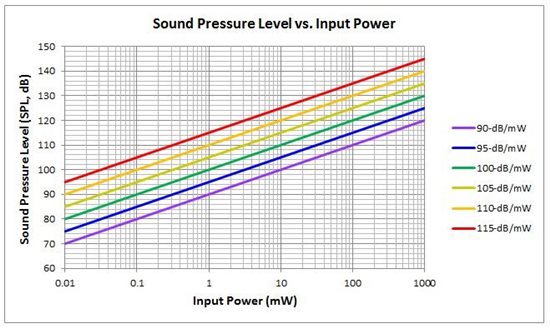When we wanted to create an op amp for a headset application (the OPA1622 op amp was chosen), the first problem we had to solve was determining the power required by the headset.
Think of headsets and speakers as converters that convert input electrical power into audible output power. As with all processes, this electroacoustic conversion process has an associated efficiency problem. As you may have guessed, the efficiency of different types of headsets varies. Overall, earbuds are less efficient than in-ear headphones.
Headphone manufacturers usually express the efficiency of their products in terms of sound pressure level ([SPL], in decibels) at a specific input power (usually 1mW). For example, a headphone manufacturer may label their headphone's efficiency as 100dB/wM, you should read this value as "100dB at 1mW". By using the benchmark efficiency given by the manufacturer, you can use equation 1 to calculate the SPL produced at other power levels:

In equation 1, PIN represents the input power to the headset, while η is the efficiency at the 1mW reference power level. Figure 1 shows the output SPL provided as the input power continues to increase for a range of common headset efficiencies.

Once you have established an SPL target, determining the signal level requires only some basic electrical engineering equations (equations 2 and 3) :


Both equations include the nominal headphone impedance, RHP, which is also specified by the headphone manufacturer. Headphones designed for portable electronic devices have low impedance (as low as 16Ω) because the low-voltage signal on the headset will still provide enough power. For those headphones used in non-portable applications, such as those used in professional recording studios, their impedance can be up to 600Ω.
Let's apply all this information to a design example to calculate the signal voltage and current required to reach a particular SPL for a common pair of flat magnetic earphones.

Using Equation 1 or Figure 1, first determine the input power required to reach the SPL target value:

Next, calculate the voltage and current needed to deliver this amount of power to the headset:


In this example, the combination of a low-impedance headset with an inefficient and very loud maximum SPL target value enabled our design team to recognize the challenges faced in the OPA1622 design. Obviously, the amount of current our amplifier needs to deliver to some headsets will be quite significant (by operational amplifier standards). With this in mind, we turned our attention to the OPA1622 output circuit. This circuit needs to be able to transmit large amounts of current without distortion.
免责声明: 本文章转自其它平台,并不代表本站观点及立场。若有侵权或异议,请联系我们删除。谢谢! Disclaimer: This article is reproduced from other platforms and does not represent the views or positions of this website. If there is any infringement or objection, please contact us to delete it. thank you! |


